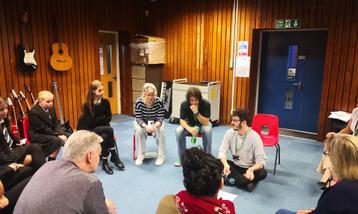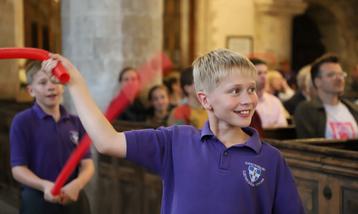Mastercard BRIT Awards campaign: A quest for more equitable music access
NewsNews Story
Sooree Pillay, Regional Producer - Midlands, shares her thoughts on current access in the music industry, music-making and creative journeys.
It felt quite surreal as I stood in the audience for the BRIT Awards at the O2 arena, at the beginning of March this year. I hadn’t bought a ticket to be among those trying to spot Kylie or Dua Lipa in the sea of celebrities mingling in the seats below, nor was I expecting to be able to share in seeing the moment of Raye’s historic award-winning night live and right there in front of me.
I was invited in my capacity as Regional Producer – Midlands for Orchestras Live. I was representing one of a number of Trailblazers in a campaign run by BRITS sponsors, Mastercard, to highlight individuals and organisations making change for young music makers in the UK. As I reflected on the experience during my train journey home, apart from wondering how it all came about, my mind began to wander to wider questions around the music industry, music-making and our creative journeys.

The Mastercard campaign was launched in the run up to the BRIT Awards, and we were delighted to have been highlighted as an organisation striving with our partners to provide inspirational orchestral experiences to more people, whatever age or background. The work towards truly equitable access to music and music-making is ongoing, and deeply embedded in our organisational principles. It is not without its challenges, however, and breaking down barriers takes time and tenacity.
This, in the context of music provision for young people, was the theme of a panel discussion hosted by radio DJ Vic Hope, to launch the campaign, where I spoke alongside fellow Trailblazer, Birmingham-based Liz J Birch – a fantastic young musician and music leader, Mastercard Ambassador and musician Young Athena (who performed a set at the BRITS afterparty), and BRIT School Principal Stuart Worden. We shared perspectives on our respective creative areas, what is at the heart of our work, the structures in society that create barriers and the drive for equity that we all have in one way or another.
I felt privileged to be in the company of the other Trailblazers: Kris Halpin, Geo Aghinea, Gawain Hewitt, Megan Steinberg, Joe Hastings and Liz J Birch. As our conversations developed, I was fascinated to learn more about them and the people they work with.
The big night arrived, and after a rather chaotic hour getting ready in my hotel room, Liz and I were reunited with everyone at the impressive O2 arena complex. I had never been before, and was rather overwhelmed, excited and happy to be there. With dancers dangling (I thought rather precariously) from the rafters, the scene was set for the ceremony to begin. If I am honest, it has been a long time since I have attended a gig of this scale, and it felt strangely other-worldly – perhaps I had returned to a previous life as a twenty something year-old?
It was nice to be able to dance and cheer alongside my companions in London, and it made me think about all of us, and how we had arrived there. I thought about pop music, and of the young people I work with in the Midlands – how we make decisions and how decisions are made for us from a young age as to the musical genres we experience, and how we experience them. It took me back to the same question of access and inclusion. Who is invited to which parties – who belongs and who doesn’t? It struck me that many pop artists have learnt orchestral instruments as children, perhaps been involved in ensembles, and at some point have perhaps decided, or thought they had to discard this aspect of their musicality to go down this path. As a society, do we encourage young people to relinquish one musical path in favour of another?
I have seen successful pop musicians return to orchestral music later on in their careers and as their practice develops. Is this a mark of becoming more adventurous or experimental, or is it a question of resource? We know that orchestral music is an expensive game, and for an artist to be able to draw these genres together requires a certain amount of support and for the door to be open, especially when starting out.
I conclude, for now, that this is the very point – why it was so special for me to have been invited to be a part of this campaign. The door was opened both ways – an offer as well as a challenge for me, in my work, to explore a world where orchestral experiences with children and young people can co-exist more with genres such as pop. I venture to state the obvious, though I believe it is worth simply reaffirming, that we don’t always need to decide or discard, and that all parts of our musical experiences can have a comfortable home together and make for a richer tapestry in our lives.


